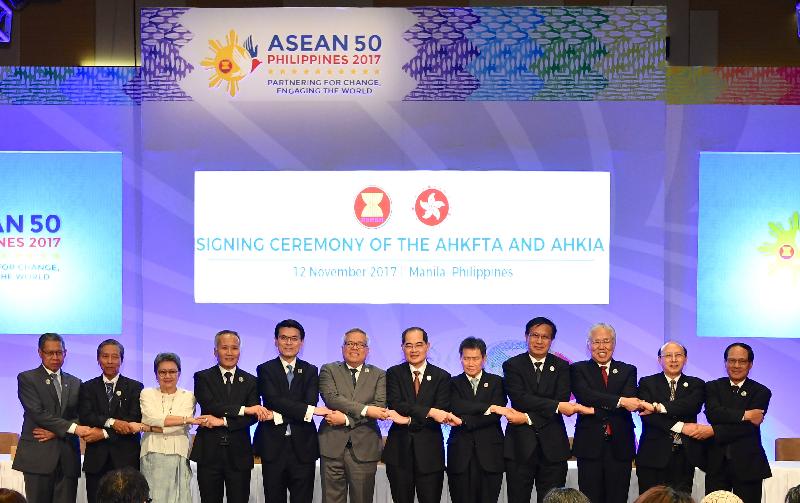
November 2017
Robin Lee
With negotiations having concluded in early September, the ASEAN-Hong Kong- Free Trade Agreement (AHKFTA) was formally signed at the 31st ASEAN Summit held in the Philippines earlier this month. A related invested agreement, the ASEAN-Hong Kong Investment Agreement (AHKIA) was also signed at the same time as the AHKFTA.
With negotiations between Hong Kong and ASEAN having lasted three years before they were concluded in July, the agreements cover trade in goods and services, investment, economic and technical co-operation and dispute settlement mechanisms. The aim is for both agreements to come into force by the 1st January 2019. The AKFTA represents the sixth Free Trade Agreement (FTA) that ASEAN has signed with external partners, having already signed FTAs with China, Korea, Japan, India and Australia-New Zealand. ASEAN and these partners with which it already has FTAs are also in the process of negotiating a multilateral FTA, the Regional Comprehensive Economic Partnership, between them all.
The significance of the AHKFTA for the Hong Kong and Chinese governments and capital.
Full details of the agreements have not been made available yet. Nevertheless, the new FTA has implications not only for trade between Hong Kong and ASEAN but more importantly also has significance for these two locations in relation to mainland China.
Hong Kong has long been important for trade between China and ASEAN countries. At the end of 2015, ASEAN ranked sixth among Hong Kong’s destinations for outward FDI (with a stock of HK$218 billion) as well as sixth among sources of inbound direct investment (with a stock of HK$555 billion).[1] According to Bank of China estimates, between 2010 and 2015 Chinese capital accounted for approximately 27% of total investments from Hong Kong to ASEAN[2]. Meanwhile government ministers in ASEAN countries have also reportedly emphasized the advantages of Hong Kong’s position as a gateway to mainland China for those wanting to do business.[3]
The AHKFTA has also been seen as important by both the government and business communities for China’s Belt and Road initiative (BRI). With the ASEAN region an important part of BRI corridors, and Hong Kong an important connection point between the mainland and overseas countries more generally, the AHKFTA has also been viewed as means for Hong Kong to further this initiative. Hong Kong Chief Executive Carrie Lam, for instance, has remarked on how the FTA, “will further enhance flows of trade and investment between Hong Kong and ASEAN, at a key intersection for the Belt & Road”.[4] Meanwhile, Jonathan Choi, chairman of the Chinese General Chamber of Commerce based in Hong Kong, has described the AHKFTA as an opportunity to further cooperation of the two sides under the BRI[5].
This might be considered particularly important due to the fact that China has already established a Free Trade Area (the CAFTA) with ASEAN in 2010 that did not include Hong Kong. This earlier agreement may therefore have acted to reduce the volume of trade passing through Hong Kong between mainland China and ASEAN since the China-ASEAN FTA generally requires that goods shipped between these locations and that claim tariff preferences are directly shipped between members of the agreement[6]. With the signing of the AHKFTA and the liberalization of trade between Hong Kong and ASEAN countries, such restrictions concerning connections between the three locations may become a lesser concern as the free trade regime is extended. Another FTA, the Closer Economic Partnership Agreement (CEPA), first signed in 2003 and further supplemented since then, already exists between China and Hong Kong designed to reduce tariffs, liberalise trade and promote investment between the two sides.
Due to Hong Kong’s status as a free port and liberal trade regime it has been suggested that the AHKFTA is more about persuading ASEAN to lower barriers so as to further flows of capital, good and services from Hong Kong.[7] Although Hong Kong has long been important in China-related trade, at a time that Hong Kong’s cargo throughput has been declining, but intra-Asian trade has been growing, from the perspective of Hong Kong business, the signing of the AHKFTA may be viewed as a way to enhance its position as a trading hub, particularly following the signing of the early China-ASEAN FTA from which it was excluded. The AHKFTA will potentially act to more fully integrate Hong Kong into mainland China’s trade relationships with ASEAN.
Considering this further degree of economic integration and mainland China’s aim of pushing forward the BRI, it is not surprising that China has been keen for the AHKFTA to be agreed upon. Indeed, it has further been suggested that Beijing is likely to have played a role in bringing about the agreement especially in alleviating reluctance by some ASEAN members. Singapore, for instance, fearing that it would lead to a decline in its own position, previously objected to Hong Kong’s participation in the China-ASEAN Free Trade Area, however Beijing has reportedly allayed such fears over the AHKFTA.[8]
Why question the AHKFTA?
While the signing of the agreement may be seen as advantageous to the Hong Kong and Chinese governments and capital, and supported by ASEAN governments, the AHKFTA represents another example of an agreement, signed between governments, which prioritises business interests at the expense of the people they supposedly represent. Free trade agreements remove or lower social, ecological and labour standards and further remove accountability away from ordinary people and their governments, leaving trade in the hands of unregulated market competition. As a result FTAs have often had devastating effects on the poor, especially in developing countries, for instance such as was seen in Mexico in the years after the North American Free Trade Agreement (NAFTA) was implemented. Meanwhile the CEPA between Hong Kong and mainland China has formed a part of the increasing economic and political integration of Hong Kong with the mainland, which has seen a decline in Hong Kong autonomy and increased political interference from Beijing. CEPA has also contributed to soaring home prices in the city, while rents have also soared impacting on residents and smaller businesses.
For South-east Asia, when the earlier FTA between ASEAN and China was being negotiated, critical voices raised concerns over the way that the agreement would disproportionately benefit China, as a stronger economic power whose growth was taking place at the expense of South-east Asian countries. Amongst concerns was the idea that an increase in imports of low value added manufactured goods produced by China would flood the markets and hurt local producers and workers in some ASEAN countries. Some also raised concern over how low wages in China would drive down or lead to phasing out of operations of comparatively high wage manufacturers in Southeast Asia[9], however others, in addition to raising this concern, have also observed how, in view of the rising labour costs in China at that time, increased economic cooperation could increase Chinese investment in ASEAN countries[10]. Since then, as wages have risen in China, largely as a result of workers’ struggles, some factories have been relocating from China to Southeast Asian countries such as Vietnam, Cambodia and Myanmar. Meanwhile China’s investments in ASEAN countries have been increasing, something which has been given further impetus since China’s Belt and Road Initiative was launched. Although there has been increased economic cooperation, since the Free Trade Area came into effect it has also resulted in a growth in a huge trade deficit that ASEAN faces with China[11], while the flooding of markets with Chinese products has indeed been noted as a detrimental impact by some countries[12].
Therefore overall it can be said that while concerns can again be raised about the effects that the AHKFTA will have on Southeast Asian countries, especially as Hong Kong acts as an intermediary location for trade and investment between overseas countries and China, and about the undermining of labour and environmental protections, in Hong Kong, the AHKFTA might also provide an additional reason for people to feel uneasy. This is because of the way that the AHKFTA may potentially, combined with the way it acts to advance China’s Belt and Road Initiative, play a part in accelerating the loss of Hong Kong’s political and economic autonomy as it becomes further aligned and integrated with mainland China in accordance with Beijing’s agendas.
[1] GovHK. Hong Kong and ASEAN conclude Free Trade Agreement Negotiations. 9th September 2017. http://www.info.gov.hk/gia/general/201709/09/P2017090700673.htm
[2] Wong Sze Wah, The Role of Hong Kong in China’s Investment in the ASEAN Market, Economic Review, September 2017.
[3]e.g. Philia Siu. ‘Hong Kong-Asean free-trade deal to be signed by November’: Philippine Minister. 13th July 2017. http://www.scmp.com/news/hong-kong/economy/article/2102420/hong-kong-as…
[4] Carrie Lam. Reaping Belt-Road Benefits. 11th September 2017. http://www.news.gov.hk/en/record/html/2017/09/20170911_125736.lin.shtml
[5] Song Lifang. Hong Kong-ASEAN FTA to enhance cooperation under Belt and Road Initiative: expert. 19th September 2017. Xinhua. http://news.xinhuanet.com/english/2017-09/19/c_136621350.htm
[6]William Marshall. ASEAN-HK FTA : What does it mean for Hong Kong and Singapore. 20th September 2017. http://www.straitstimes.com/opinion/asean-hk-fta-what-it-means-for-hk-a…
[7]Frank Chen. To ASEAN with love: An FTA that can be a win for HK, China. 19th September 2017. http://www.ejinsight.com/20170919-to-asean-with-love-an-fta-that-can-be…
[8] Ibid
[9] Walden Bello. China’s neo-colonialism. 9th March 2010. https://newint.org/features/web-exclusive/2010/03/09/chinas-neocolonial…
[10] Artur Gradziuk. Implications of ASEAN-China Free Trade Agreement (ACFTA). The Polish Institute of International Affairs Bulletin. No.8 (84).
[11] Between 2010 when the ACFTA was enacted and 2013 ASEAN’s goods trade with China went from a surplus to a deficit of $45 billion. See: Nargiza Salidjanova and Iacob Koch-Wese. China’s Economic Ties with ASEAN: A country by country analysis. 17th March 2015. U.S.-China Economic and Security Review Commission: Staff Research Report.
[12] Lee Xin En. ASEAN FTA with China ‘a mixed blessing’. 19th July 2016. http://www.straitstimes.com/business/asean-fta-with-china-a-mixed-bless…
